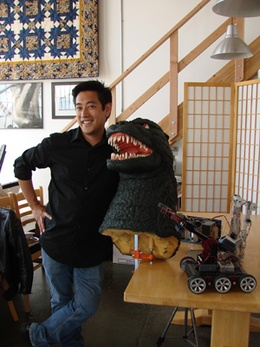Flashback to 1954: “Godzilla” makes its big screen debut. Directed by Ishiro Honda and produced by Toho Studios in Japan, the film, which featured a man in a rubber suit demolishing a scale model of Tokyo, represented the cutting edge of special effects in cinema. You’ve come a long way, baby!
Since then, audiences all over the world have been dazzled by increasingly sophisticated special effects in blockbusters like “Star Wars,” “Jurassic Park,” and “The Matrix.” But, while everyone knows the films and, in many cases, the directors whose visions appear onscreen, what about the people who make it all happen?
Meet Grant Imahara, electronics and radio-control specialist. He is part of the generation of special effects masters that has taken the world by storm. Over the course of his career, he has worked on such movies as “The Lost World: Jurassic Park;” “Star Wars: Episode I—The Phantom Menace;” “Terminator 3: Rise of the Machines;” “AI: Artificial Intelligence;” and “Van Helsing” for Industrial Light & Magic, and “The Matrix Reloaded” and “Revolutions” for EON Productions.
Grant is also the author of the book ”Kickin’ Bot: An Illustrated Guide to Building Combat Robots.” His own robot fighter, Deadblow, is a former “BattleBots” Champion. “BattleBots” was a weekly television series in which home-made robots fought each other, gladiator-style; usually ending up with one of the robots becoming nonoperational. Recently, Grant’s been getting recognition for his role on the popular Discovery Channel show “Mythbusters.” The program takes urban legends and uses science to prove or disprove them. Grant is on the “Build Team” which was originally created to assist the show’s main hosts, but now functions as its own separate team with its own myths to bust every episode.
Nikkei Heritage was lucky enough to sit down with the effects guru to talk about his career and his life.
First off, what was your experience growing up as a Japanese American like? How has your identity developed since then?
We moved around a lot when I was little, so I was constantly the new kid. I can remember being chased around the schoolyard on Pearl Harbor day, and having been made fun of for my name and looks. Eventually, I learned how to make friends quickly, which helped later in life. At USC, I worked at the Asian Pacific American Student Services Department and helped to organize various events and programs for Asian Pacific American students. I also participated in the APA Leadership Development Program, a joint project between USC, UCLA, and Loyola Marymont University aimed at empowering APA high school students.
What was your favorite movie to work on and why?
One of my favorite movies I’ve worked on was actually not a big effects extravaganza, but the “Star Trek” spoof “Galaxy Quest.” It was a fun movie, and our work really shined. Since it was a spoof of “Star Trek,” it was a great opportunity to work on a detailed model spaceship, like all the Enterprise models in the “Star Trek” movies that had come before.
What initially got you interested in working with robot-like machines and special effects?
I’ve been fascinated with robots and mechanical systems as far back as I can remember. I’m one of those kids who took all the wheels off his Matchbox cars and constantly took things apart.
I played with Lego building blocks endlessly. I grew up watching movie robots like R2-D2 and C-3P0 and they were a big part of my childhood. I went into electrical engineering and then took up machining and mechanical engineering on the side as a way to fuel my fascination with robots. My hobby, building a combat robot for BattleBots, was a way to combine my skill with something fun.
I know you’ve worked on some high profile movies like “Jurassic Park,” “Terminator 3,” “AI,” and “Van Helsing,” as well as both “The Matrix Reloaded” and “Revolutions.” What was your role in these films?
At Industrial Light & Magic, my job was to handle anything that moved or lit up. This meant I worked on robots or mechanical effects as well as any miniature lighting effects, such as spaceship engines or miniature street lights. On “Jurassic Park: The Lost World,” I put the lights in the miniature Jurassic Park stadium as well as a scale breakaway dock that a ship (also a miniature) crashed into. On “Terminator 3,” I helped build and light a model of a particle accelerator. On “AI: Artificial Intelligence,” I supervised the construction of the “Tails” building in Rouge City, the underwater Radio City Music Hall, and I supervised the miniature lighting of many of the other Rouge City buildings. I also did a large amount of CAD work and laser cutting for the underwater New York sequence. For “Van Helsing,” I did the miniature lighting on Dracula’s castle, small caves in the sides of the mountain, spooky rooms, and the long bridge where several action sequences take place. For the “Matrix” movies, I worked on the dock in Zion, and the crane in the middle of the dock that collapses as a result of a Sentinel attack. I worked on the Digger mechanical rig that punches through the ceiling and falls to the ground. There are too many projects to mention for the “Star Wars” series...
What is the process of operating robotic characters, such as R2-D2 or the Energizer Bunny?
Often, when you’re working on a set with a robot such as R2-D2 or the Energizer Bunny, there’s a lot of waiting around. However, when it’s your time to perform, you have to perform perfectly every time. I remember one time I drove the Energizer Bunny across a precarious countertop 42 times in a row, executing a perfect spin in the middle of each run. I once drove the robotic vacuum cleaner that chased Dave Chappelle and his Pepsi around an apartment. We were shooting in the middle of the night at a loft in Manhattan, and I had been waiting around for hours. It came time, and they set me up where I couldn’t really see the vacuum. I just lucked into a perfect run, but that was one of the few high-stress moments for me.
You were in the Asian American comedy troupe the 18 Mighty Mountain Warriors. What was your role in that troupe and how did you get involved?
I was one of the founding members of the 18 Mighty Mountain Warriors as a writer and performer. In college, I had been a part of the group HereAndNow, a college-aged drama and comedy performing troupe based in Southern California. After graduation, I moved to the Bay Area in 1993, and was looking for a similar group at about the time when the members of the New Godzilla Theatre troupe were looking to form something new. They wanted to create a writer-driven, skit-based comedy group. After a few small shows at the Asian American Theater Company in San Francisco, the group galvanized into the 18 Mighty Mountain Warriors, which is based on the name of one of the skits. I left the group after a few years to concentrate on my career at ILM.
What’s your favorite aspect of working on the show “Mythbusters”?
Perhaps my favorite thing to do is build something that could be considered really dangerous, such as a sword-swinging robot that just happens to be neck-height, or a powerful car-mounted nitrogen cannon that fires a metal grappling hook.
I also enjoy being surprised by the results of a myth, such as “Bull in a China Shop.” Everybody knows that saying, meaning that someone is clumsy and prone to knocking things over. When we actually released a live bull in our makeshift china shop, not a single thing broke! In fact, we released half a dozen bulls at the same time, and they all gracefully avoided the plate-lined shelves. Results like that only go to remind us that we work on a reality science show, and you can’t always predict the outcome.
Would you say it can be hazardous to work on special effects in the movie industry? What’s your most frustrating moment as a special effects master either on “Mythbusters” or any of the movies you worked on?
It’s true that we are often in dangerous situations on “Mythbusters.” That’s the nature of trying to re-create the circumstances of a myth that involves fire, explosives, high voltage, and the like. However, what most people don’t know is that we have insurance. In fact, every experiment that we perform has to be examined by an underwriter. If we’re in a potentially hazardous situation, we’ll have experts like bomb technicians, police, firemen, paramedics, and others to make sure that we’re safe, and that no one gets hurt. We’ve done very well so far.
There are a lot of outtakes from “Mythbusters” available on YouTube. I noticed that many of them involve fans trying to prove or disprove that you cursed on camera. What do you think of people putting all this effort into showing you with a foul tongue?
I think it’s pretty silly that someone would put that much effort into proving or disproving that I’ve used a curse word. Perhaps they feel that they need to bust my “squeeky-clean” image? Whatever spins their wheels, as long as they watch and enjoy the show.
What do you think about the special effects movement as it grew from the movie “Godzilla” to the dazzling “Star Wars”-type special effects?
Although “Godzilla” is a particularly well-known, classic example, visual effects actually date back to the dawn of the movie industry. Visual effects have indeed come a long, long way from the early days. One of my favorite periods was during the 70s, where practical models and blue screen technology were the chief tools of the trade. “Star Wars,” “Battlestar Galactica,” “Buck Rogers,” and a number of other effects-driven TV shows and movies were being made, and it made a really big impression on me. I look back fondly on those days and the sense of wonderment that those effects created.
Do you work with students who hope to follow in your footsteps and one day become a Grant Imahara or even a George Lucas or Stephen Spielberg? What do you do to mentor them or encourage them?
I mentor a group of high school students at Richmond High School in Richmond, California (which is in fact the very same school that is featured in the “Coach Carter” movie).
They compete in a national robotics program called FIRST [For Inspiration and Recognition of Science and Technology], which was started by Dean Kamen, the inventor of the Segway transporter. We teach the value of teamwork and sportsmanship as well as basic fabrication skills, which is something that has been eliminated from numerous school curriculums these days. One of the best parts of the program is that both boys and girls participate, and their contributions are equal in this arena. I’ve been doing this for close to eight years now, and now many of my students have gotten scholarships and gone on to careers in engineering as a result of their involvement with this program, which is a tremendous thing, especially since Richmond High School isn’t in a great part of town, and resources are scarce for these students.
* This article was originally published in Nikkei Heritage Vol. XIX, Number 2 (Summer 2008), a journal of the National Japanese American Historical Society.
© 2008 National Japanese American Historical Society





